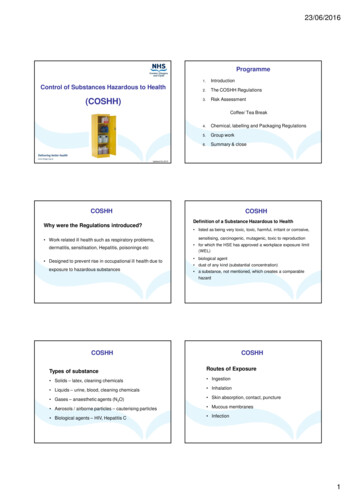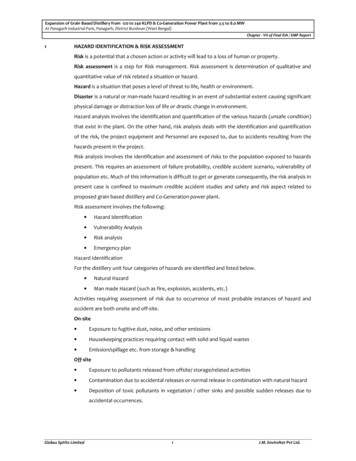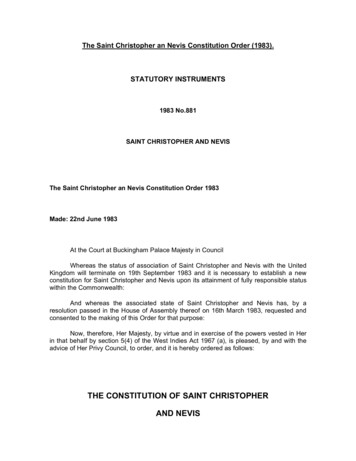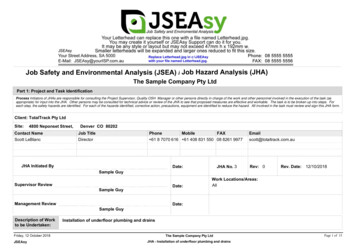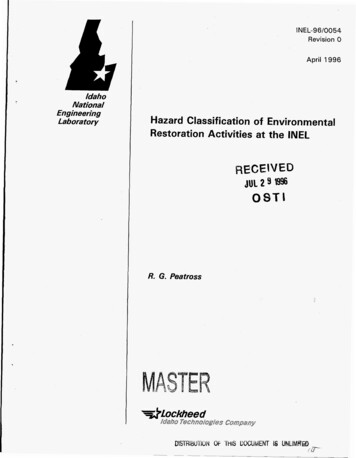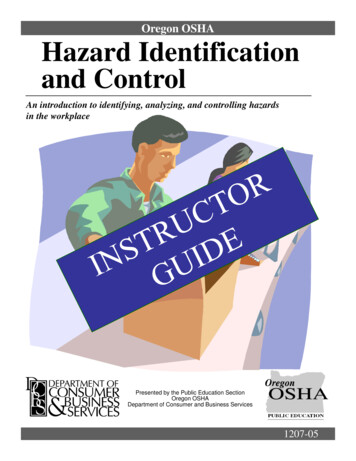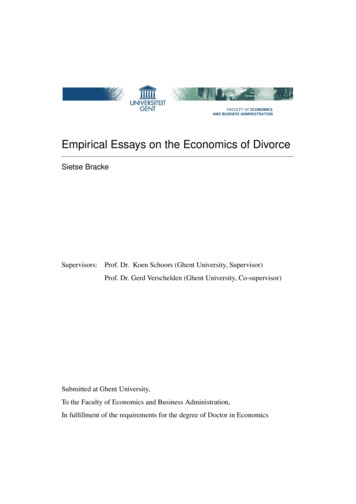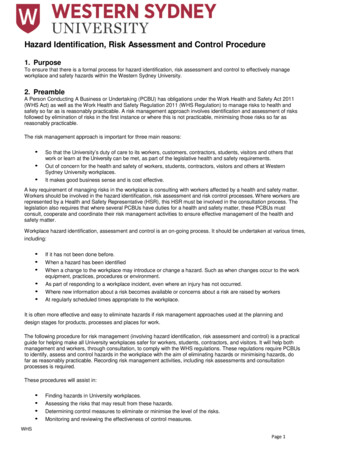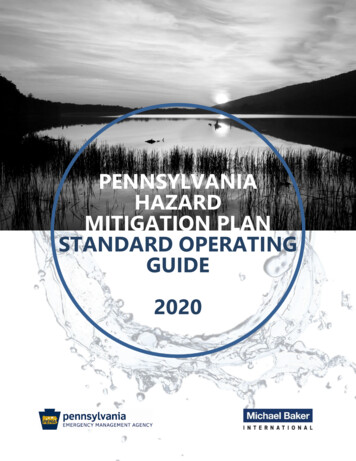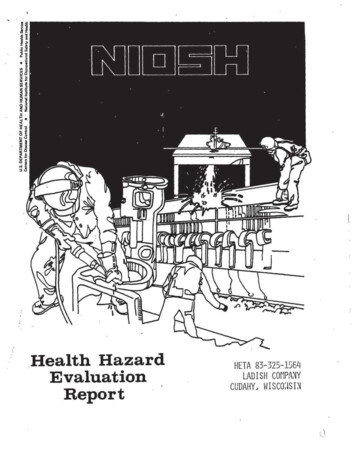
Transcription
Health HazardEvaluationReportHETA 83-325-1S64LADISH cor1PANYCUDAHY) w1sco;1s1 .'-\.
PREFACEThe Hazard Evaluations and Technical Assistance Branch of NIOSH conducts fieldinvestigations of possible health hazards in the workplace. Theseinvestigations are conducted under the authority of Section 20(a)(6) of theOccupational Saf ty and Health Act of 1970, 29 U.S .C. 669(a)(6) whichauthorizes the Secretary of Health and Human Services, following a writtenrequest from any employer or authorized representative of employees, todetermine. whether any substance normally found in the place of employment haspotentially toxic effects in such concentrations as used or found.The Hazard Evaluations and Technical Assistance Branch also provides, uponrequest, medical, nursing, and industrial hygiene technical and consultativeassistance (TA) to Federal, state, and local agencies; labor; industry andother groups or individuals to control occupational health hazards and toprevent related trauma and disease.Mention of company names or products does not constitute endorsement by theNational Institute for Occupational Safety and Health.
NIOSH INVESTIGATORS:William J. Daniels, CIHPeter Orris. M.D.Sara Arnold, M.D.HETA 83-325-1564FEBRUARY 1985LADISH COMPANYCUDAHY, WISCONSINI.SUMMARYOn June 20, 1983, the National Institute for Occupational Safety andHealth (NIOSH) was requested to evaluate asbestos exposure amongmaintenance workers at a metal forging and machining plant owned by theLadish Company in Cudahy, Wisconsin, and to assess the adequacy of thecompany's medical monitoring program for the workers.Action on the request was initially delayed pending the resolution of asimilar investigation being conducted by the Occupational Safety andHealth Administration (OSHA}. In January 1984, NIOSH investigatorsconducted an initial visit to the facility. Following this survey,environmental and medical records were obtained from the company, andchest radiographs, which had been obtained by the company, were reviewedby an independent NIOSH certified a-reader.A review of the environmental monitoring data conducted by the companyindicated a total of 28 "maintenance type activities which involved apotential for asbestos exposure since 1981. Supplied-air respiratoryprotection was reported to be utilized . during all but four of theseactivities, during which disposable dust respirators had been providedfor respiratory protection. Airborne concentration of asbestos measuredoutside the worker's respirators (thus potential employee exposures)during these operations were generally below 0.1 fibers/cc as an 8-hourTWA; however, in two activities employee exposures were reported toexceed the OSHA PEL for asbestos. In one of these activities, asbestosconcentrations exceeded (by less than a factor of 3} the OSHA PEL of 10fibers/cc as a ceiling concentration, and in a second activity, asbestosconcentrations exceeded (by less than a factor of 2} the OSHA PEL of 2fibers/cc as an 8-hour TWA. It should be noted that supplied-airrespirators had been utilized during the first operation, and disposabledust masks during the latter operation. A review of the company'swritten work procedures indicated that Type C supplied-air respiratorsare currently used in maintenance operations involving potentialasbestos exposure.0A review of the company's medical monitoring program for asbestosexposed employees revealed some shortcomings, particularly in regards tothe quality of chest radiographs. Of the 11 chest radiographs reviewedby the NIOSH certified a-reader, five were judged to .be unreadable forthe assessment of asbestos-related lung disease.Ont e basis o t e 1n ormat,on o ta ned dur1ng this survey, themedical monitoring program for employees exposed to asbestos did notappear adequate .for the early detection of asbestos-related lungdisease. Recommendations designed to improve the medical monitoringro ram and reduce em loyee ex osures are included in this re ort.KEY WORDS: SIC 3462 (Iron and Steel Forgings) Asbestos, Asbestosis,a-reader
HEALTH HAZARD EVALUATION No. 83-325 - Page 2II . INTRODUCTIONOn June 20, 1984, an authorized representative of the employees atLadish Company, Cudahy, Wisconsin, requested that the National Institutefor Occupational Safety and Health (NIOSH) conduct a health hazardevaluation at the facility. The requestor was concerned with asbestosexposure to maintenance employees who had worked in the plant over thepast several years.Further action on the health hazard evaluation request was delayedpending the outcome of a similar investigation being conducted by theOccupational Safety and Health Administration (OSHA}. Following asettlement of the OSHA ·citation, codified by a consent decree concerningmedical surveillance of certain asbestos exposed employees, NIOSHinvestigators conducted an initial survey visit to the facility onJanuary 17, 1984. An opening conference was held with representativesof plant management and the local union during which the nature of therequest was discussed, and areas where asbestos removal operations hadoccurred were inspected. Following this survey, information wasobtained from the company related to environmental and medicalmonitoring, and. the current quality assurance procedures for jobsinvolving potential asbestos exposure. Subsequently, company medicalrecords and x-rays were obtained for review by the NIOSH Medical Officerand a NIOSH certified B-reader.III. BACKGROUNDThe Ladish Company, founded in 1905, is engaged in the production ofpipe fittings and industrial forgings. At the time of this survey, theplant employed approximately 850 administrative, 1200 production, and300 maintenance employees. Throughout the history of the company,asbestos had been used in a variety of materials and applications withinthe facility. Over the past four years, operations which were conductedinvolving potential employee exposure to asbestos included: the use ofTransite (an asbestos-Portland cement composite employed as aninsulation and construction material}, the removal of asbestos coveringson electrical wiring, the removal of asbestos containing insulation fromsteam supply lines, the drilling and cutting of Transite in theinduction Heating Coil Preparation Area, the removal of brick and blockfurnace insulation containing 1% amosite asbestos, and the ·removal ofexpansion joints, gaskets and asbestos-containing refractory materialsfrom furnaces.Although employees in many job categories may have been potentiallyexposed to asbestos in the past, the employees who were identified asbeing in jobs with a potential for engaging in asbestos-related workactivities (through removal operations etc.} were all employed in themaintenance department. These potentially exposed employees includedapproximately 3 pipecoverers, 16 maintenance helpers, 5 carpenters, 8masons, and 40 electricians.
HEALTH HAZARD EVALUATION No . 83-325 - Page 3IV. MATERIALS AND METHODSDuring the initial survey visit of January 17, 1984, information wasobtained related to the past and present use of asbestos in the plant,and the job classifications and numbers of employees identified ascurrently having a potential for asbestos exposure.Since the requestor was concerned with employee exposures which hadoccurred in the past, the company's medical monitoring program for thoseemployees exposed to asbestos was reviewed for its adequacy.Additionally, since there were still some isolated activities conductedduring which a potential for asbestos exposure existed, the hazardpresented by these operations was also assessed. Due to the relativeinfrequency, the unplanned nature, and the variability of the types ofthe activities with potential asbestos exposure, environmentalmonitoring was difficult to arrange and sample results would only berepresentative of the particular operation monitored. Therefore, inlieu of environmental monitoring of isolated work activities by NIOSHresearchers, a review of the company's "Quality Assurance Procedures 11(which included work practices, personal protection, and environmentalmonitoring for asbestos) was conducted in order to determine if properprecautions were being taken to adequately prevent asbestos exposures tomaintenance employees.In order o provide for a more in-depth assessment of these areas, aletter was sent to the company on February 10, 1984, requesting thefollowing information for review:A. Environmental1) the most recent revision of the written quality assurance and safetyprocedures for asbestos handling and removal operations,2) a copy of the current respiratory protectioi:i program for thoseemployees involved in asbestos handling and removal operations,3) environmental monitoring records for asbestos conducted by thecompany or OSHA since January 1981,B. Medical1) the medical protocols being utilized for surveillance of the healtheffects of asbestos,2) a listing of those job categories currently screened for the healtheffects of asbestos,3} medical records related to asbestos surveillance of thQse maintenanceemployees enrolled in the asbestos surveillance program, and4) the most recent chest r·adiographs of the maintenance employees inthis surveillance program.This information was provided to NIOSH in April 1984. However, since"copies" of the original chest radiographs were initially upplied,NIOSH subsequently requested the ori gi nal radiographs, which werelater provided. These radiographs were submitted, to an independentNIOSH certified B-reader for review. In January 1985, NIOSHinvestigators requested and were provided with additional informationregarding the scope of the company's asbestos surveillance program.IIII
HEALTH HAZARD EVALUATION No. 83-325 - Page 4V. EVALUATION CRITERIAAs a guide to the evaluation of the hazards posed by workplaceexposures, NIOSH field staff employ environmental evaluation criteriafor assessment of a number of chemical and physical agents. Thesecriteria are intended to suggest levels of exposure to which mostworkers may be exposed up to 10 hours per day, 40 hours per week for aworking lifetime without experiencing adverse health effects. It is,however, important to note that not all workers will be protected fromadverse health effects if their exposures are maintained below theselevels. A small percentage may experience adverse health effectsbecause of individual susceptibility, a pre-existing medical condition,and/or a hypersensitivity {allergy).In addition, some hazardous substances may act in combination with otherworkplace exposures, the general environment, or with medications orpersonal habits of the worker to produce health effects even if theoccupational exposures are controlled at the level set by the evaluationcriterion. These combined effects are often not considered in theevaluation criteria. Also, some substances are absorbed by .directcontact with the skin and mucous membranes, and thus potentiallyincrease the overall exposure. Finally, evaluation criteria· may changeover the years as new information on the toxic effects of an agentbecomes available.The primary sources of environmental evaluation criteria for the ·workplace are: 1) NIOSH Criteria Documents and recommendations, 2) theAmerican Conference of Governmental Industrial Hygienists' {ACGIH)Threshold li.mit Values (TLV's), and 3) the U.S. Department ofLabor/Occupational Safety and Health Administration (OSHA) occupationalhealth standards. Often, the NIOSH recommendations and ACGIH TLV's arelower than the corresponding OSHA standards. Both NIOSH recommendationsand ACGIH TLV's usually are based on more recent information than arethe OSHA standards. The OSHA standards also may be required to takeinto account the feasibility of controlling exposures in variousindustries where the agents are used; the NIOSH-recommended standards,by contrast, are based primarily on concerns relating to the preventionof occupational disease. In evaluating the exposure levels and therecommendations for reducing these levels found in this report, itshould be noted that industry is required by the Occupational Safety andHealth Act of 1970 (29 USC 651, et seq.) to meet only those levelsspecified by an OSHA standard.A time-weighted average {TWA) exposure refers to the average airborneconcentration of a substance during a normal 8 to IO-hour workday. Somesubstances have re ommended short-term exposure limits or ceiling valueswhich are intended to supplement the TWA where there are recognizedtoxic effects from high, short-term exposures.A. AsbestosAsbestos is a generic term applied to a number of hydrated mineralsi 1i cates, including chrysotil e, amosite, c·rocidol ite, tremol i te, andanthophyllite. Asbestos consists of fibers of varying size, color, and
HEALTH HAZARD EVALUATION No. 83-325 - Page 5texture. The uses of asbestos are numerous and include thermal andelectrical insulation, fire blankets, safety garments, filler forplastics, and roofing materials. The most toxic route of entry isinhalation. The most widely recognized diseases caused by asbestos areasbestosis, cancer of the lungs and digestive tract, and mesotheJioma.Asbestosis is a lung disorder characterized by a diffuse interstitialfibrosis, including pleural changes of fibrosis and calcification. Theworker exhibits restrictive pulmonary function, with clinical findingswhich may include fine rales, finger clubbing, dyspnea, dry cough, andcyanosis. These findings may be delayed 10 - 15 years in onsetfollowing cessation of exposure.Bronchogenic and gastrointestinal carcinomas, as well as mesotheliomasof the pleura and peritoneum are also caused by asbestos exposure .These cancers may occur following a limited exposure years earlier.1Due to its carcinogenic nature, NIOSH recommends that employee exposuresto asbestos be reduced to the lowest feasible limit. The NIOSHrecommended standard set in September 1976 is 0.1 fibers greater than 5microns in length per cubic centimeter (fibers/cc), which was at thattime the lowest level detectable by phase contrast microscopy .2 Phasecontrast microscopy is considered the only practical analyticaltechnique currently available to industry and official agencies which isvalid and reproducible. It should be noted that recent improvements inthe reproducibility and sensitivity of the sampling and analyticalmethod now allow for detection of fiber concentrations as low as 0.01fibers/cc in some environments depending on background contamination3The current OSHA standard for -asbestos is an 8-hour TWA exposure is 2fibers/cc, and 10 fibers/cc as a 15-minute ceiling concentration.4The ACGIH has recommended the following TLV's for asbestos fibersgreater than 5 microns in length; 0.2 fibers/cc for crocidolite, 0.5fibers cc amosite, 2.0 fibers/cc chrysotile, and 2.0 fibers/cc for otherforms.B. Medical SurveillanceAppropriate medicalprogression of someshould be placed onpotentially exposedaction level of 0.1surveillance is crucial to detect and m1n1m1ze theasbestos-related disease. Considerable emphasisbaseline medical examinations for all workersor who are exposed to asbestos at or above the OSHAfibers/cc.1. Medical Examinations shall include, as a minimum:4,6A history to elicit symptomatology of respiratory disease, smokingexperience, and prior asbestos exposure;A physical examination emphasizing cardiovascular and pulmonarypathology;A chest roentgenogram (posterior-anterior 14 x 17 inches);Pulmonary function tests to include forced vital capacity (FVC) andforced expiratory volume at 1 second (FEVl.O);
HEALTH HAZARD EVALUATION No. 83-325 - Page 6In addition, sputum cytology should be considered for exposed smokingemployees.These examinations should be provided by the employer to each of hisemployees prior to the time of first exposure, at the termination ofemployment, and annually if the employee is regularly exposed and asmoker, and biannually if the patient is regularly exposed and not asmoker. If the employee is no longer exposed, did not have long-termsubstantial exposure, and has no asbestos-related changes on chest x-rayon by pulmonary function studies, no specific asbestos medicalsurveillance is necessary. A medical removal protection program shouldbe in place for employees showing signs of asbestos-related disease.All medical examinations should be promptly reviewed and the resultsreported to the employee, who should have access to independent medicalreview of these results. Medical records should be retained byemployers for at least 40 years or for 20 years after termination ofemployment, whichever is longer. Furthermore, there should be periodicreporting of aggregate . medical information concerning the entire exposedworkforce. Results should be displayed in an aggregate format, deletinginformation that would identify individuals, in a location accessible tothe employees and their representatives.VI. RESULTS AND DISCUSSIONA. EnvironmentalA review of the information contained in the company's latest revisionof the "Quality Assurance Procedures" indicated that written proceduresdesigned for the protection of employees engaged in work with asbestoswere in place, and contained in two major documents addressing the scopeof these acti vi ti es. The first, entitled "Respirators; Purchase, Use,Maintenance, Storage & Employee Training" (revised 1/30/84) covered thebasic elements of a respiratory protection program as specified by OSHAstandards 29 CFR 1910.134. This included sections covering programadministration, medical requirements, respirator selection, employeetraining and fit testing, ·and respirator mafotenance, care, and storage.A second document, entitled "Asbestos, Handling and Safety Procedures"(revised 5/19/83) covered the procedures to be used in identifying,handling, or removing asbestos-bearing materials. In summary, thisdocument specified that overall program administration was to be carriedout by the Safety and Chemistry Departments, with MaintenanceSupervision responsible for implementing all specified controlmeasures. Prior to any job activity where insulating material was to beremoved, the supervisor was to perform an inspection of the job site,and collect samples of any material suspected of containing asbestos.The Chemistry department would then analyze the sample by "acommercially available test kit" or other appropriate means. If thetest is negative, then work would proceed without the use ofrespirators. If the test is positive, the job would be delayed untilconfirmational tests were carried out. If the job could not be delayed,all aspects of the procedures for working wi.th asbestos would be put in
HEALTH HAZARD EVALUATION No. 83-325 - Page 7place. It should be noted that during the course of the evaluation, thecompany acquir d in-plant polarized Microscopic capabilities. Thisshould help to eliminate potential problems associated with theanalytical screening procedures previously employed.In addition to the areas identifie as containing ashestos hy trepreviously mentioned method, the asbestos work rrocedures would al so herequired for those areas included on a list of possibleashestos-containing furnaces, whic is puhlisherl annually.The specific work practice and personal protection to · he employed werealso specified in this document. Thi includerl directives for thesecuring and posting of areas of asbestos work, the wetting of materialsprior to work, cautions against fracturing or abrading materials tominimize c!ust generation, and the proper sealing of v1aste materials andwork clothing in containers bearing appropriate labelling for disposalin an appropriate landfill . Personal protection provided to theemployee \oJas to include a Type 11 C11 supplied air respirator, eithercontinuous-flow or pressure-demand . Additionally, disposable coveralls,head coverings, ploves, and foot coverings were to be provided whereasbestos concentrations could be expected to exceerl the OSHA ceilinglevel of 10 fibers/cc. During asbestos removal operations, airmonitoring was to be performed and maintained as prescribed in section1910.1001 of the OSHA Act.3A review of tne information supplied hy the company regardingenvironmental monitorinq for asbestos exposure inricated a total of 28"maintenance type" activities which had been conducted since 1981 andinvolved a potential for asbestos exposure. Broadly categorized, theseactivities inclucten, 16 operations involving the removal of pipeinsulation, seven involving the removal of furnace components ( askets,.ioints, or refractory mr1.tf'rials), tlJJO involving the removal of ceilinginsulation, and single occurrences of miscellaneous activities;including the removal of asbestos from electrir:al wiring, cleAn-up ofasbestos- containing matP.rial, and removal of a m0tor from an area whereasbestos was present. Air-supplied respiratory protection was reportedto be utilized durin all but fo11r of these activities, during \'lhichNIOSH/MSHA approved disposable dust respirators had been provided forrespiratory protection (these w re primarily utilize in activitiesoccurrinq in 1981 and 1982). While NIOSH continues to approvesingle-u;e and replaceable dust/mist respirators for use againstasbestos because of legal reouirements, NIOSH does not recommend the useof such respirators where exposure to ashestos may occur on the hasisthat such is not a prudent occupational health risk.The frequency of employee exposure during these activities was asfollows; one employee was involved in thirteen eparate pipe insulationremoval operations, a second employee was involved in two separate pipeinsulation removal operations, a third employee was involved in t\"JOmiscellaneous activities, with the· remainin9 employees reported as beinginvolved only in single nperations where ashestos was deter in d tn bepresent. Asbestos concentrations outside the worker's respirator (thuspotential employee exposures) Pasured rturinq these npPratinns were enerally helow 0.1 fibers/cc as an 8-hour THA; however, in t\110activities potPntial employee exposures were reported to exc:eed the OSHAPEL for asbestos. In one of these activities, asbestos concentrationseXCPP. ed (by less than a factor of 3) tbe OSHA PEL of 10 f i bers/cc as a
HEALTH HAZARD EVALUATION No. 83-325 - Page 8ceiling concentration, and in a second activity, asbestos concentrationsexceeeded (by less than a factor of 2} the OSHA PEL of 2 fibers/cc as an8-hour TWA. It should be noted that air-supplied r spirators had beenutilized during the first operation, and disposable dust masks duringthe latter operation.B. MedicalA review of the company's medical policy indicated that ·it providesfollow-up medical examinations on an annual basis for the followingemployees:1} Electricians from the maintenance department whose jobs involve themin work with electrical insulation,2) An employee whose job involves removing insulation from pipes,3) Selected employees form the Metallurgy Department whose jobs includeperforming analytical tests on samples of material which containsasbestos, and4) Nine maintenance department employees who were included in themedical surveillance program as part of the two settlement agreementswith OSHA in 1982.Each examination includes a physical and spirometry. A chest x-ray isincluded in the examination when, in the opinion of the company'sMedical Director., it is medically needed and safe for the employee. Theemployees are eligible for the medical examinations as long as theyremain employed by the company or have r hiring rights. The decision tohave an examination is voluntary on the part of each employee. Asummary of the results of the medical examination are forwarded to eachemployee ·30 days after the examination.Summary medical reports prepared by the company Medical Director werereviewed by the NIOSH Medical Officer. One report was from 1980., sixfrom 1982, and four from 1983. The reports each contained a briefhistory, physical examination., chest radiograph, and pulmonary functionstudy. ten o f the records contained a summary impression which includedthe phrase "no signs of asbestos lung disease". However., the one recordreviewed that did not contain a summary impression by the MedicalDirector, was judged by the company radiologist to have changes possiblyconsistent with asbestos exposure.The original radiographs of the 11 maintenance employees participatingin the company's asbestos surveillance program were submitted to anindependent radiologist who is a NIOSH certified B-reader forevaluation. This independent review was in agreement with the originalcompany secured radiographic interpretation for all 11 employees for allnon pneumoconiotic pathologies. As for the evaluation ofasbestos-related pneumoconiosis, five of the films were judged to beunreadable under the UICC/ILO standards for the ssessment of·asbestos-related lung disease. The remaining six films were found tohave been correctly taken and interpreted by the original radiologist.
HEALTH HAZARD EVALUATION No. 83-325 - Page 9VII. CONCLUSIONS AND RECOMMENDATIONSA. EnvironmentalThe company should continue in its efforts to eliminate the use ofasbestos, substituting materials with low chronic toxicities whereverpossible. The acquisition of in-plant polarized light microscope .capabilities, which occurred during the period of the survey, shouldgreatly help to eliminate the potential problems associated with lessreliable screening methods and the uncertainty of the materialcomposition during the time required for outside analysis.The revision of the Quality Assurance Procedures, which was provided toNIOSH for review, addressed the key elements of employee personalprotection and work practices as required by OSHA regulations. However,some additional recommendations are provided below to enhance theeffectiveness of the current procedures.1. A systematic program of identifying asbestos-containing materialswithin the facility should be implemented (information supplied bythe company indicates that such a listing is currently publishedannually for asbestos-containing and non-asbestos-containingfurnaces). Such information would heJp to alleviate inadvertentemployee exposures to asbestos and enable early identification ofareas which may pose potential exposure problems due to physicaldamage or deterioration.2. Since the potential for the contamination of skin, hair, or clothingmay exist despite the use of disposable coveralls, the current workprocedures should include provisions addressing changing of workclothing, showering, and personal hygiene.3. The use of wetting agents designed to enhance water penetration andreduce the possibility of fiber dispersion should be examined forinclusion in those applications where they might prove beneficial.4. Since a potential for contamination of nearby work areas may existduring asbestos removal operations where significant fiberconcentrations are generated, the possibility of exposure in theseareas should be routinely assessed, with enclosure of the work areaor other measures taken as appropriate.B. MedicalThe company and union should be commended for developing a medicalsurveillance program for asbestos exposed employees. The scope of thisprogram included the provisions of the OSHA standards and many of theNIOSH recommendations. However, the following additionalrecommendations are made in order to further enhance this surveillanceprogram.1. Since almost 50% of the X-ray films reviewed were determined to betechnically inadequate for the evaluation of asbestos-relatedchanges, the company should include the use of a NIOSH certifiedB-reader for chest radiographs in their surveillance program .
HEALTH HAZARD EVALUATION No. 83-325 - Page 102. The environmental data supplied by the company indicated that themajority of the maintenance employees were not regularly exposed toasbestos during the maintenance activities monitored since 1981.However, any employees who may have had significant asbestos exposureprior to this, should also be included in the surveillance program.3. The single medical evaluation with x-ray evidence of possibleasbestos lung disease contained no summary statement by the companyphysician. There is, therefore, no evidence that the companyphysician evaluated the data and communicated this evaluation to theemployee. All medical evaluations should contain a summaryimpression by the company physician, and this impression as well asthe information on which it is based, should be communicated to theemployee.4. Because cigarette smoking enhances the carcinogenic effect of.asbestos on the lung, particular emphasis should be placed on thedevelopment of an educational program toward smoking cessation forthose potentially exposed employees who currently are smokers.VIII. REFERENCES1. Proctor, N.H. and Hughes, Chemical Hazards of the Workplace.Philadelphia, PA: J.B. lippencott Company, 1978.2. National Institute for Occupational Safety and Health. RevisedCriteria for a Recommended Standard - Occupational Exposure toAsbestos . Cincinnati, Ohio: National ·Institute for OccupationalSafety and Health (NI0SH)1977. DHEW(NIOSH) Publication No. 77-169.3. National Institute for Occupational Safety and Health. NIOSH Manualof Analytical Methods, Volume 1, Third Edition. Cincinnati, Ohio:·National Institute for Occupational Safety and Health (NI0SH}1984.DHEW{NIOSH) Publication No. 84-100.4. Code of Federal Regulations, 29:1900-1910, U.S. Department of Labor,Occupational Safety and Health Administration, 1980.5. American Conference of Governmental Industrial Hygienists,Documentation of Threshold Limit Values, Fourth Edition. AmericanConference of Governmental Industrial Hygienists, Cincinnati, Ohio,1980.6. National Institute for Occupational Safety and Health.Work PlaceExposure To Asbestos, Cincinnati, Ohio: National Institute forOccupational Safety and Health (NIOSH)1981. DHEW{NIOSH} PublicationNo. 81-1033
HEALTH HAZARD EVALUATION No. 83-325 - Page 11IX.
HETA 83-325-1564 NIOSH INVESTIGATORS: FEBRUARY 1985 William J. Daniels, CIH LADISH COMPANY Peter Orris. M.D. CUDAHY, WISCONSIN Sara Arnold, M.D.

